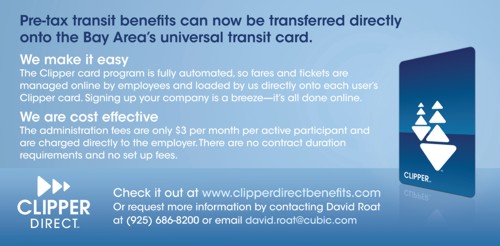Clipper is the New TransLink, New Card Debuts June 16
Clipper is the New TransLink, New Card Debuts June 16
It has been almost four years since the universal transit card TransLink went into service, in the fall of 2006. Intended as the single ticket to ride on all Bay Area transit systems, the reloadable card was first deployed on AC Transit and Golden Gate Transit buses and ferries. Its successive roll-out has been slow but steady, as each adopting agency puts all functions to the test before full implementation.
In May 2009, the fare card was certified as "Revenue Ready" for the BART system, meaning that it had "successfully passed all laboratory and field tests," according to the Metropolitan Transportation Commission (MTC). Based in Oakland near the Lake Merritt BART station, the MTC is the transportation planning, financing. and coordinating agency for the nine-county Bay Area. As part of those duties, it also oversees the TransLink program.
The smart card became fully operational on BART last August and is now accepted by five of the region's transit agencies: Muni, BART, AC Transit, Caltrain, and Golden Gate Transit and Ferry. With VTA and SamTrans rollouts expected later this year, the service will soon be available to the majority of Bay Area transit users.
The timing is perfect for a new identity, especially one that harkens back to California's first glory days - and represents a significant breakthrough in the history of transportation. The Clipper ship was a new class of streamlined merchant vessel that started to appear in the late 1840s. According to the MTC, its "speed and cargo capacity transformed transportation to Gold Rush San Francisco from everywhere in the world." Running almost twice as fast as its predecessors, a Clipper could beat the record for sailing from New York to San Francisco around Cape Horn by as much as 110 days.
"The idea is to tie in with Bay Area heritage," MTC spokesman John Goodwin has said."It all came back to the Gold Rush era. What was the fastest method of transportation then? The Clipper ships."
The MTC believes that the new name and logo will make the transit program "more appealing" to potential customers. The new card "also takes away any confusion with other local programs such as FasTrak, Fast Pass, as well as several other transportation programs around the world that are also named TransLink" - in British Columbia and Australia, for example.
Clipper will work exactly the same way that TransLink does today, holding multiple passes, ride books, or tickets, as well as up to $300 in e-cash at one time. Users simply touch their card to the card reader for verification, and all appropriate discounts and transfers are applied automatically. The new Clipper cards will be available at all retailers that currently offer TransLink cards; current TransLink card holders do not need to exchange their cards.
MTC has also introduced a Direct Benefits option, in which riders can put pre-tax transit dollars directly onto their Clipper card and use that money to pay transit fares. For more information about the program, visit www.translink.org.
Also in this issue...
- Polycom's Unified Collaboration Solutions Emphasized in New Alliance
- Weight Watchers Promotes Transformation, Not Dieting
- Business Bits
- Executive Profile: Will Cox, Pacific Medical Prosthetics & Orthotics
- SynchroNet Helps Customers Save Money, Reduce Carbon Emissions with Container Repositioning
- Fast-Growing Wunderlich-Malec Engineering Specializes in Systems Reliability
- Overnight or Over a Week, Hacienda Hotels Offer a Hospitable Welcome to Travelers
- Pathways Archive is Treasure Trove of Pleasanton History
- Clipper is the New TransLink, New Card Debuts June 16
- Hacienda Special Offers - for Summer and Beyond
- Great Race for Clean Air 2010
- Hacienda Index
- Calendar





